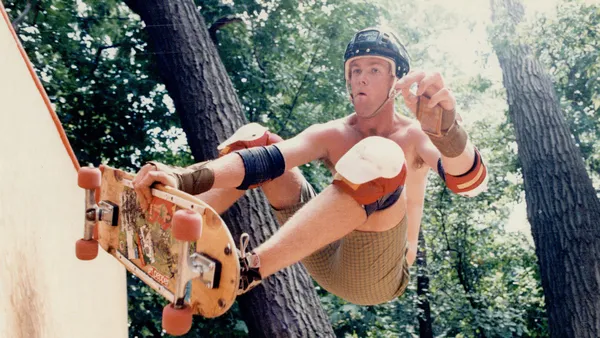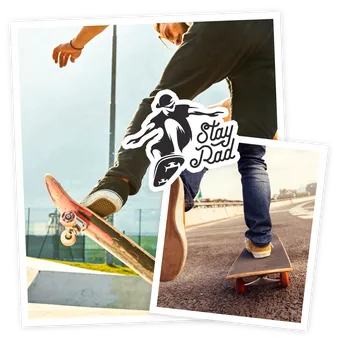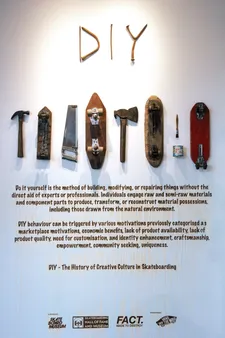Table of Contents
Prepare to embark on a captivating journey through The history and culture of skateboarding, a sport that embodies freedom, creativity, and individuality. From its humble origins to its current status as a global phenomenon, skateboarding has left an undeniable mark on popular culture. Join Kizworld as we delve into the rich heritage, vibrant community, and captivating stories that make skateboarding more than just a pastime—it's a way of life.
The History and Culture of Skateboarding: Thrills, Skills, and Identity
I. Skateboarding: Origin and Evolution
Skateboarding's roots can be traced back to the early 20th century, when surfers in California sought a way to catch waves when the ocean was flat. They attached wheels to wooden boards and began riding them on sidewalks and in empty swimming pools. This rudimentary form of skateboarding gained popularity among young people who were drawn to its thrill and freedom. Over the years, skateboarding evolved and diversified, giving rise to different styles, disciplines, and competitions.
From Sidewalks to Skateparks: A Timeline of Skateboarding's Growth
Decade | Significant Developments |
|---|---|
1950s | |
1960s | |
1970s | |
1980s | |
1990s | |
2000s | |
2010s |
The Impact of Skateboarding Culture
- Skateboarding has had a profound impact on popular culture, influencing fashion, music, and art.
- Skateboarding has also been credited with promoting creativity, self-expression, and individuality.
- Skateboarders have a strong sense of community and often form close bonds with fellow skaters.
- Skateboarding has been used as a tool for social change and empowerment, particularly among marginalized communities.
Today, skateboarding continues to evolve and attract new enthusiasts worldwide. It remains a vibrant and dynamic sport that offers a unique blend of athleticism, creativity, and personal expression.
Related Posts:
II. Exploration of Skateboarding's Dynamic Culture
Exploration of Skateboarding's Dynamic Culture
Skateboarding has evolved into a global phenomenon, captivating enthusiasts worldwide with its unique blend of athleticism, creativity, and self-expression. Its dynamic culture extends beyond the physical act of riding a skateboard, encompassing a vibrant community, a rich history, and an ever-evolving landscape of tricks and styles. In this section, we delve into the captivating world of skateboarding culture, exploring its origins, its impact on society, and its enduring appeal.
The roots of skateboarding can be traced back to the early 20th century, when surfers in California sought a way to continue riding waves when the ocean was flat. They attached wheels to wooden boards and began experimenting with different maneuvers on land. Over the years, skateboarding evolved into a distinct sport, with its own unique set of tricks, competitions, and cultural norms. Today, skateboarding is practiced by millions of people around the world, and its popularity continues to grow.
One of the most striking aspects of skateboarding culture is its emphasis on creativity and self-expression. Skateboarders are constantly pushing the boundaries of what is possible on a skateboard, inventing new tricks and styles that reflect their individual personalities and perspectives. This creativity extends beyond the physical realm, as skateboarders also express themselves through art, music, and fashion. Skateboarding has become a platform for self-expression, allowing individuals to showcase their unique talents and perspectives.
Skateboarding has also had a significant impact on society, particularly among young people. It has been credited with promoting physical activity, encouraging creativity, and fostering a sense of community. Skateboarding has also been used as a tool for social change, with many skateboarders using their platform to speak out against injustice and promote positive values. In addition, skateboarding has had a major impact on popular culture, inspiring countless works of art, music, and film.
The enduring appeal of skateboarding lies in its ability to provide a sense of freedom and exhilaration that is unmatched by many other activities. Skateboarding allows individuals to explore their surroundings in a new way, to push their physical limits, and to express themselves creatively. It is a sport that is accessible to people of all ages and backgrounds, and it offers a unique way to connect with others who share a passion for the sport.
Skateboarding culture is a vibrant and ever-evolving phenomenon that continues to captivate people around the world. Its emphasis on creativity, self-expression, and community makes it a powerful force for positive change. As skateboarding continues to grow in popularity, it is likely to have an even greater impact on society in the years to come.
Name | Nationality | Years Active |
Tony Hawk | American | 1980-present |
Rodney Mullen | American | 1970-present |
Nyjah Huston | American | 2006-present |
Paul Rodriguez | American | 2002-present |
Ryan Sheckler | American | 2003-present |
Whether you are a seasoned skateboarder or just curious about the sport, there are many ways to get involved in skateboarding culture. You can find skateparks and skate shops in most major cities, and there are numerous online resources that can help you learn more about the sport. If you are interested in trying skateboarding, it is important to start slowly and learn the basics before attempting more advanced tricks. With a little practice, you can quickly master the fundamentals of skateboarding and start enjoying the many benefits that the sport has to offer.
In addition to skateboarding, there are many other related activities that you can enjoy. These include:
- Longboarding: This is a variation of skateboarding that uses a longer, wider board. Longboarding is often used for cruising and transportation, but it can also be used for tricks and stunts.
- Rollerblading: This is a similar sport to skateboarding, but it uses inline skates instead of a skateboard. Rollerblading is a great way to get around town or just have some fun.
- Scootering: This is a sport that uses a scooter, which is a small, two-wheeled vehicle that is propelled by pushing off the ground with one foot. Scootering is a popular activity for kids and adults alike.
No matter what your interests are, there is sure to be a skateboarding-related activity that you will enjoy. So get out there and start exploring the world of skateboarding!
III. Skateboarding's Influence on Style and Fashion
Skateboarding's Influence on Style and Fashion
The skateboarding culture has had a profound impact on style and fashion. In its early days, skateboarding was seen as a rebellious and counter-cultural activity. As a result, skateboarders often dressed in clothing that reflected their outsider status. They wore baggy clothes, ripped jeans, and bandanas. They also sported long hair and facial hair.
Over the years, skateboarding has become more mainstream. As a result, the clothing associated with skateboarding has also changed. Today, skateboarders are just as likely to be seen wearing streetwear brands as they are to be seen wearing traditional skateboarding clothing.
- Skateboarding Shoes: Skateboarding shoes are designed to provide support and stability for the feet. They also have a flat sole, which makes them ideal for gripping the skateboard.
- Skateboarding Pants: Skateboarding pants are typically baggy and made from durable materials. They also have reinforced knees and pockets, which make them ideal for skateboarding.
- Skateboarding T-Shirts: Skateboarding t-shirts are typically made from cotton or polyester. They often feature graphic designs or logos.
- Skateboarding Jackets: Skateboarding jackets are typically made from denim or nylon. They are designed to protect skateboarders from the elements.
In addition to clothing, skateboarding has also influenced other aspects of fashion. For example, skateboarding has helped to popularize the use of backpacks and beanies.
Clothing Item | Description |
|---|---|
Skateboarding Shoes | Flat sole, supportive, durable |
Skateboarding Pants | Baggy, durable, reinforced knees and pockets |
Skateboarding T-Shirts | Cotton or polyester, graphic designs or logos |
Skateboarding Jackets | Denim or nylon, protects from the elements |
"Skateboarding has had a huge impact on fashion," says Emily Smith, a fashion designer who specializes in streetwear. "It's brought a lot of new trends to the mainstream, and it's helped to popularize many different styles."
The skateboarding culture is constantly evolving, and so is the fashion associated with it. One thing is for sure, though: skateboarding will continue to have a major impact on the way people dress.
Related post: The Benefits of Gymnastics for Kids
Related post: How to Do a Handstand
IV. Skateboarding: Inspiring Creativity and Expression
Skateboarding: Inspiring Creativity and Expression
In the realm of skateboarding, creativity and self-expression reign supreme. Skateboarders transform urban landscapes into their personal canvases, utilizing every nook and cranny to showcase their unique styles and perspectives. Whether it's through intricate tricks, graceful lines, or innovative approaches to obstacles, skateboarding provides a platform for individuals to express themselves in a dynamic and visually captivating manner. Learn the Basic Skateboarding Skills and Tricks
The Art of Self-Expression
Skateboarding transcends the boundaries of mere sport; it's an art form that allows individuals to communicate their innermost thoughts and emotions through movement. The way a skateboarder approaches an obstacle, the fluidity of their lines, and the creativity of their tricks all contribute to a unique narrative that reflects their personality and perspective. Top Skateboarding Competitions and Events
- Skateboarding empowers individuals to break free from societal norms and embrace their individuality.
- It fosters a sense of community and belonging among like-minded individuals.
- Skateboarding encourages perseverance and resilience in the face of challenges.
The Pursuit of Freedom
At its core, skateboarding is about the pursuit of freedom. It's about the freedom to explore, to push boundaries, and to express oneself without limitations. Skateboarders find liberation in the ability to navigate urban environments on their own terms, creating their own paths and discovering new possibilities. Most Famous Skateboarders and Legends of All Time
Skateboarding has also become a symbol of counterculture, representing a rejection of mainstream values and a celebration of individuality. It's a way for people to express their dissent and challenge societal norms, often through the medium of art and activism. How to Train Like a Skateboarder
The Future of Skateboarding
The future of skateboarding is bright, with new generations of riders pushing the boundaries of the sport and taking it to new heights. As skateboarding continues to gain popularity and recognition, it's likely to become even more integrated into mainstream culture, while still maintaining its unique identity and rebellious spirit. Best Skateboarding Apps and Websites
Skateboarding is more than just a sport; it's a way of life that embodies creativity, freedom, and self-expression. It's a culture that continues to thrive and evolve, inspiring individuals around the world to embrace their individuality and pursue their passions with unwavering determination.
V. Conclusion
Skateboarding has come a long way since its humble beginnings, evolving into a global phenomenon that continues to captivate and inspire people worldwide. Its unique blend of athleticism, creativity, and self-expression has made it a powerful force in popular culture, transcending boundaries and uniting people from all walks of life. As skateboarding continues to progress, it is exciting to imagine what the future holds for this dynamic and ever-evolving sport.